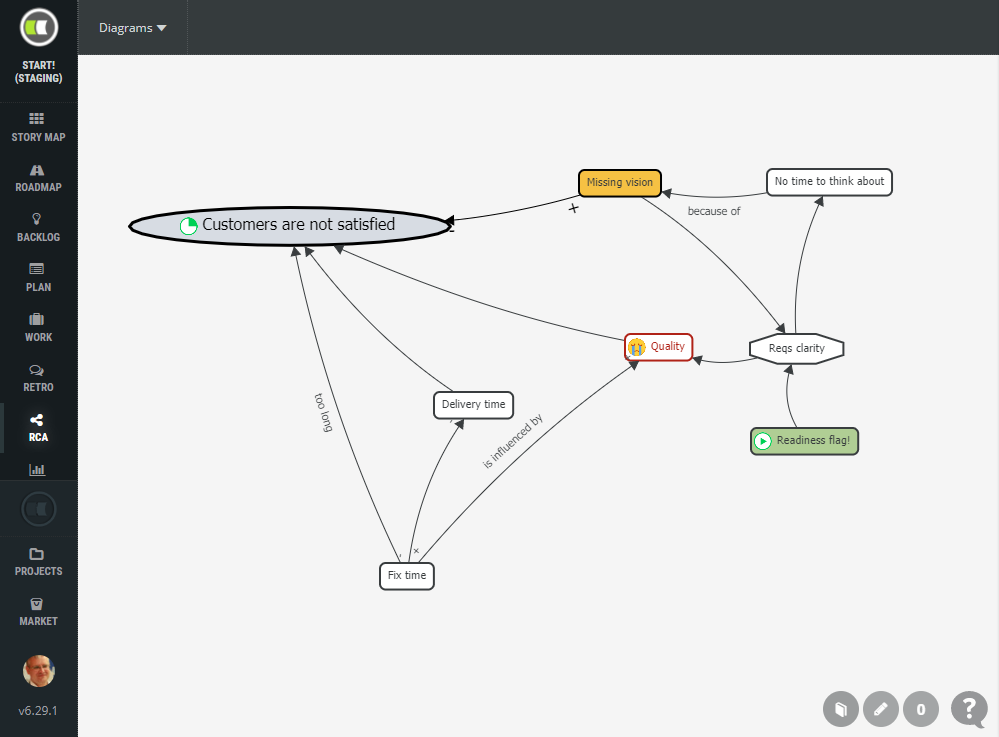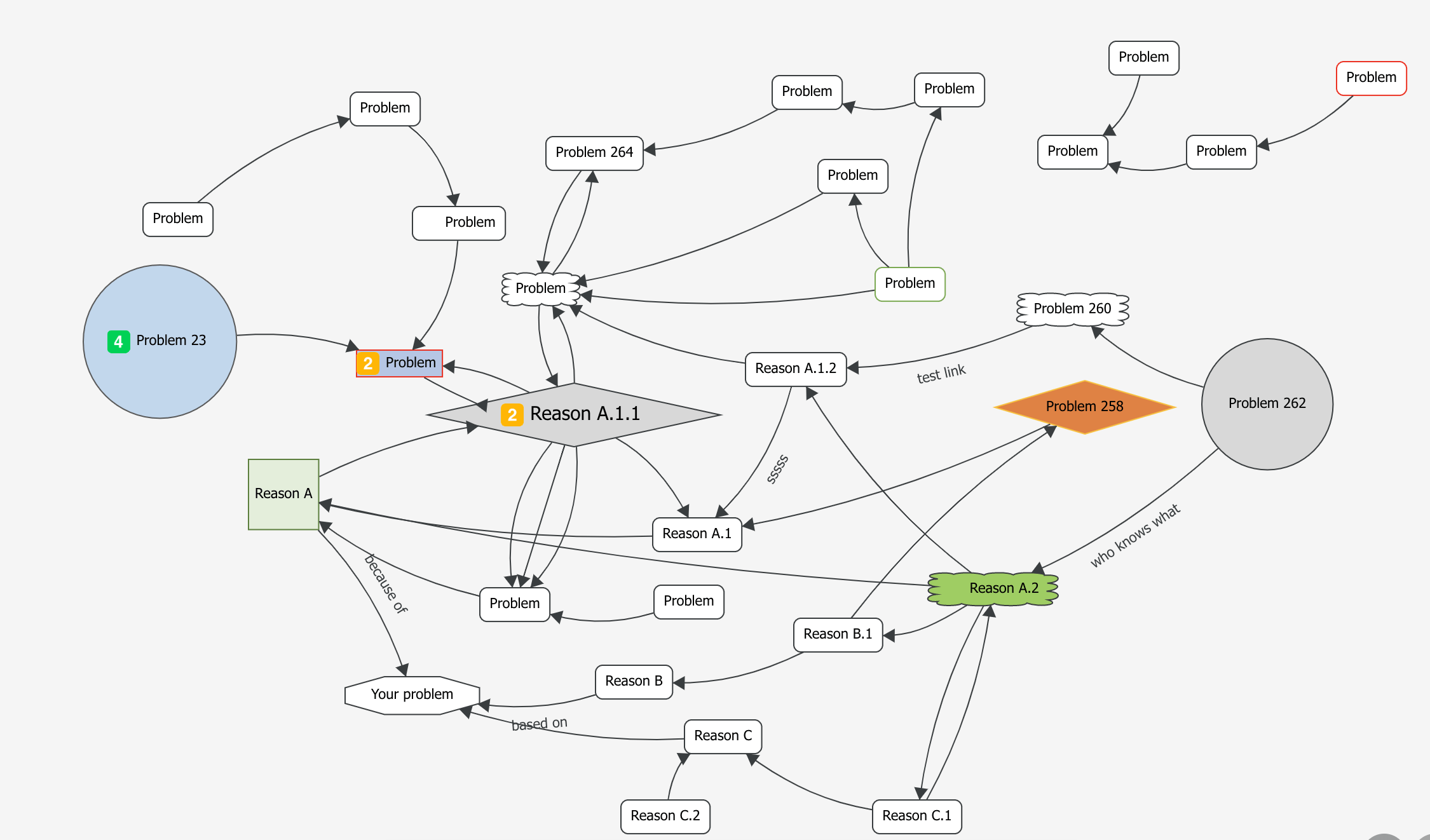Root Cause Analysis Editor
We are glad to see more and more (and especially experienced) agile teams use the Root Cause Analysis editor to build a shared understanding of the reasons for their impediments. This way agile teams can focus on the true cause of the problem instead of solving some indicators.
In this version, we redesigned the RCA editor and provided many new options so your analysis looks more, compared to the previous version, like Causal Loops Diagrams. The background is light so it is even better usable in common meetings when you present it on a wall.
New features
- Nodes
- shapes – circle, cloud, diamond, ellipse, hexagon, pentagon, rectangle, square, stop sign,
- markers for items representing emotions, progress, numbers, flags, and icons,
- fill and stroke colors,
- possibility to set the width of the stroke,
- fonts, sizes, and font colors,
- attachments.
- Links
- curved links used for better visualization & look and feel of Casual Loops Diagram,
- colors,
- fonts and font sizes,
- From and To labels to describe if the problem increases, or decreases the importance of the related problem (see Casual Loops Diagrams).
What now? Create a new diagram, insert the title of your problem and just start to ask WHY? Let the diagram help you find reasons for your Why. Mark it, prioritize root causes with colors, fonts, and shapes, set marker icons to find root causes fast. Break loops and you are there. Process optimized, problem solved!
Kanban mode
Don’t you prefer the Scrum layout of the board with backlog items and subtasks? Maybe you would prefer KANBAN STYLE! When we planned this feature, we spent many hours in discussions with product owners and teams. Both Scrum roles like Kanban-style, but for different reasons.
Are you looking for what Kanban is? Check The Kanban Glossary. What is a difference between Scrum and Kanban?
Product owners need Kanban board style to quickly see the status of the backlog items, but they still want to offer & see the implementation details with help of subtasks.
Some agile teams hate subtask. There are too many subtasks on a board! This is just a bureaucracy! Etc., etc., etc. Funny is that teams who mentioned this 90% of them had a problem with sharing of knowledge, an understanding of implementation details, a common agreement on how a feature is going to be implemented. Yes, they needed Scrum board style.
But those 10% were teams that were very agile, they wanted to remove waste in form of too many cards on the board. For them, Kanban-style is the best and enough. They deserved it. So we brought it in this version.
Cards represent backlog items assigned to the sprint. To switch the board into KANBAN style just click the appropriate button in![]() the menu at the top. You can change the board style anytime.
the menu at the top. You can change the board style anytime.
Epic on backlog item cards
ScrumDesk Professional allows managing the product backlog in the form of a user stories map that supports a multi-level hierarchy of epics and nested features. Up to 5 levels are supported know which helps manage even more complex projects in a transparent way.
This feature is very helpful especially if you manage the requirements of multiple clients in one backlog, i.e. consultancy services.
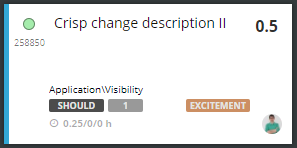
The due date for subtasks
Due dates for agile project management are oxymorons. But, except for the theory, there is a real-life in which agile needs to be mixed with non-agile approaches.
ScrumDesk’s transparency is used by many non-IT development teams to manage for example many types of services where due dates are a reality. So far due date was possible to set at the backlog item level. Multiple customers asked us to have such a possibility on the sub-tasks level as well. So here is it!
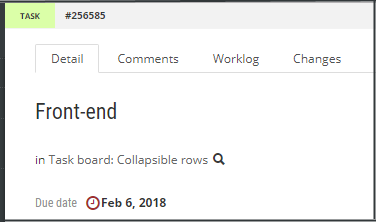
Oh, btw, the date will indicate the importance of the card:
- Green = stay calm, no pressure, relax!
- Orange = Turn on a siren, it is time to start to work on this!
- Red = Houston, Houston, we have a problem. Tomorrow is the date!
Release and sprint attachments
Minor change, but important for product owners who need to track related documents in one place for all stakeholders and team members. Keep the recordings of your discussions, UX design documents, wireframes, important agreements with the customer, or just pictures of your physical planning boards.
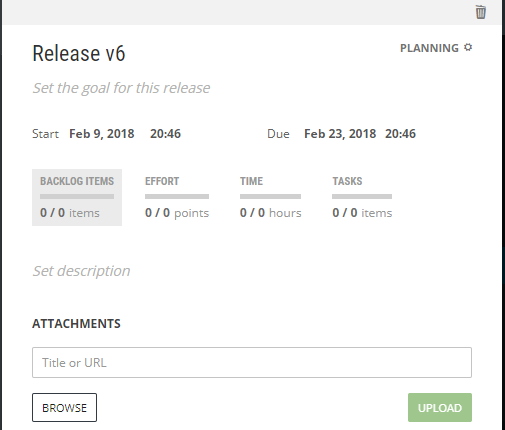
If you prefer Google Drive or DropBox, just paste the link to the file and ScrumDesk will link the release (or sprint) with those files.
Planning, Group by Epic
Minor, but useful. The product owner can group cards in PLAN view by an epic and features. We combined the full path of the feature now so you can locate them in your user story map by the title easier.
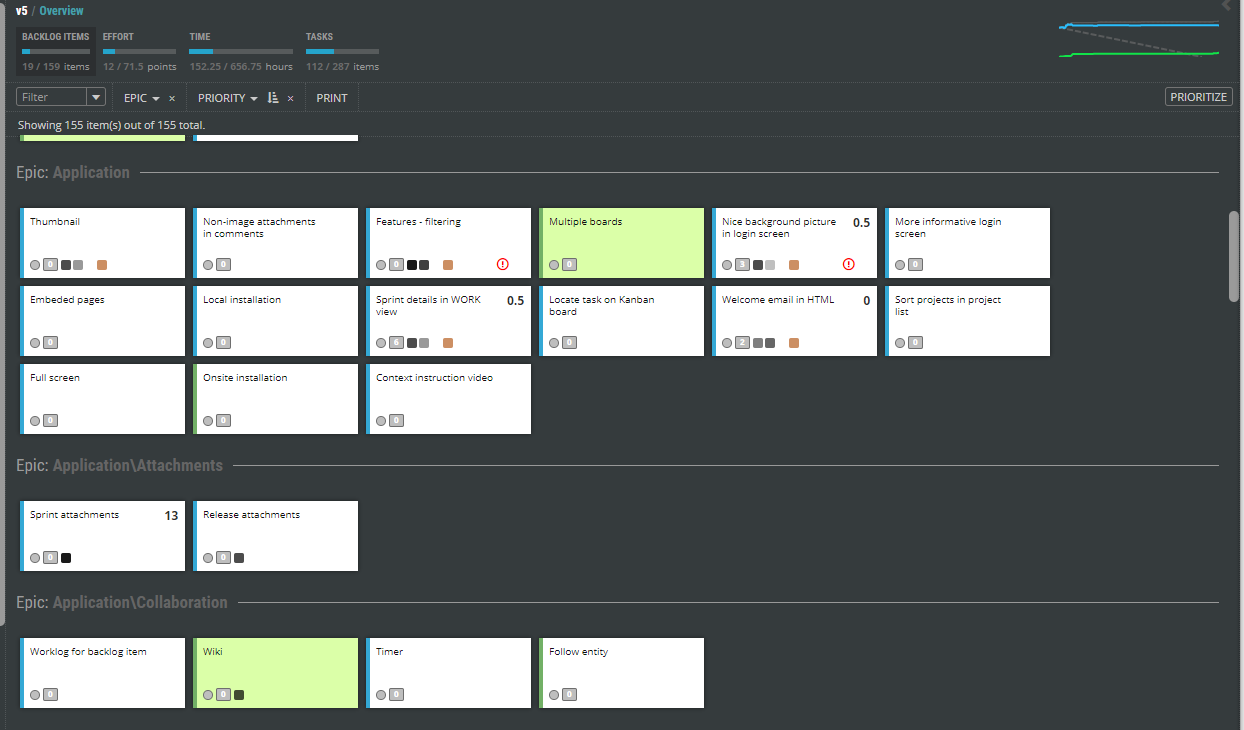
Minor changes
- Redesigned login screen
- Shortcut to access sprint details in the top menu in WORK view

- If the user story has been split, the estimated time of tasks moved to the next sprint will be set to the remaining time from the previous sprint.
- Crisper description of task changes in Changes tab
- Timesheet document displays work log comments
- Side view: a number of subtasks are displayed on the top of the subtasks list as well which is useful for backlog items with many subtasks.
- Side view: timer icon which did exactly nothing just taking a space has been removed from the subtasks list.
- Side view: narrowed time editor to provide more space for the titles.
- Filter pane layout changed to better fit Mac screens without necessary scroll.
- Backlog item card: waiting, readiness, and impediment flags are visible for all card sizes. Now you can realize your blockers even with many small cards on the screen.
- User story map: an effort is visible for all sizes of cards.
- User Story Map: hidden unnecessary id displayed in the menu of user stories templates
- Added link to Slack integration manual on the project settings page.
- The split of the backlog item is possible now to the current sprint as well. Previously it was possible only to planned sprints.
- Sorting and grouping of backlog items by the due date.
- Time to archive not used projects and accounts prolonged to 60 days.
What will be in the next version?
At least:
- Improved way of visualization of milestones in Roadmaps editor.
- Capacity planner with partial days capacity calculation.
- Multiple UX changes to faster and simplify usage of the tool with fewer clicks.
- Retrospective module improvements.
- Timesheet document with better filtering.
- WJSF prioritization + backlog items dependencies to help you with Scaled Agile Framework.

